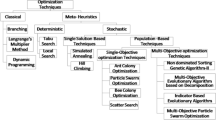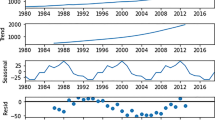Abstract
Time series data in DEA often represent successive versions of the same unit (DMU). In order to assess efficiency of each DMU, several DEA techniques have been employed. One of the problems that conventional DEA models face is that the reference set, when dealing with time series data, is not constructed correctly. This is attributed to the fact that conventional DEA models examine the DMUs and extract their efficiency scores based only the spatial dimension. However, when dealing with time series data for DMUs in the DEA context, the temporal dimension should be also taken into account. This paper is based on Spatio-Temporal DEA (ST-DEA) model (Petridis et al. in Ann Oper Res 238(1–2):475–496, 2016) and extends the presented S-T DEA model by incorporating undesirable inputs/outputs. A GAMS representation of the model for the solution and explanation of ST-DEA model is shown through an illustrative example. The scope of the paper is to analyze the concept of ST-DEA model and demonstrate its applicability via an application explained in GAMS optimization software.



Similar content being viewed by others
References
Abbott, M. (2005). Determining levels of productivity and efficiency in the electricity industry. The Electricity Journal, 18(9), 6272.
An, Q., et al. (2015). Measuring slacks-based efficiency for commercial banks in China by using a two-stage DEA model with undesirable output. Annals of Operations Research, 235(1), 13–35.
Athanassopoulos, A. D., & Thanassoulis, E. (1995). Separating market efficiency from profitability and its implications for planning. Journal of the Operational Research Society, 46(1), 20–34.
Avkiran, N. K. (2015). An illustration of dynamic network DEA in commercial banking including robustness tests. Omega, 55, 141–150.
Banker, R. D., Charnes, A., & Cooper, W. W. (1984). Some models for estimating technical and scale inefficiencies in data envelopment analysis. Management Science, 30(9), 1078–1092.
Berg, S. A., Førsund, F. R., & Jansen, E. S. (1992). Malmquist indices of productivity growth during the deregulation of Norwegian banking, 1980–1989. The Scandinavian Journal of Economics, pp. S211–S228.
Caves, D. W., Christensen, L. R., & Diewert, W. E. (1982). Multilateral comparisons of output, input, and productivity using superlative index numbers. The Economic Journal, 92(365), 73–86.
Charnes, A., Cooper, W. W., & Rhodes, E. (1978). Measuring the efficiency of decision making units. European Journal of Operational Research, 2(6), 429–444.
Chung, Y. H., Färe, R., & Grosskopf, S. (1997). Productivity and undesirable outputs: A directional distance function approach. Journal of Environmental Management, 51(3), 229–240.
Cooper, W. W., Park, K. S., & Pastor, J. T. (2001). The range adjusted measure (RAM) in DEA: A response to the comment by Stein-mann and Zweifel. Journal of Productivity Analysis, 15(2), 145–152.
GAMS CPLEX. The Solver Manuals. GAME/CPLEX, 1996.
Durmuşoğlu, A., & Dereli, T. (2011). On the technology forecasting using data envelopment analysis (TFDEA). In 2011 Proceedings of PICMET’11: Technology management in the energy smart world (PICMET). IEEE. pp. 1–6.
Emrouznejad, A., & Thanassoulis, E. (2005). A mathematical model for dynamic efficiency using data envelopment analysis. Applied Mathematics and Computation, 160(2), 363–378.
Emrouznejad, A., & Yang, G. (2018). A survey and analysis of the first 40 years of scholarly literature in DEA: 1978–2016. Socio-Economic Planning Sciences, 61, 4–8.
Färe, R., & Grosskopf, S. (1997). Intertemporal production frontiers: with dynamic DEA. Journal of the Operational Research Society, 48(6), 656–656.
Färe, R., et al. (1993). Derivation of shadow prices for undesirable outputs: a distance function approach. The Review of Economics and Statistics, pp. 374–380.
Førsund, F. R., & Kittelsen, S. A. C. (1998). Productivity development of Norwegian electricity distribution utilities. Resource and Energy Economics, 20(3), 207–224.
Giannakis, D., Jamasb, T., & Pollitt, M. (2005). Benchmarking and incentive regulation of quality of service: An application to the UK electricity distribution networks. Energy Policy, 33(17), 2256–2271.
Golany, B., & Roll, Y. (1989). An application procedure for DEA. Omega, 17(3), 237–250.
Grigoroudis, E., Petridis, K., & Arabatzis, G. (2014). RDEA: A recursive DEA based algorithm for the optimal design of biomass supply chain networks. Renewable Energy, 71, 113–122.
Inman, L.,, Anderson, T. R., & Harmon, R. R. (2005). Improving time to market forecasts: a comparison of two technology forecasting techniques for predicting US fighter jet introductions from 1944 to 1982. In Management of Engineering and Technology (PICMET), 2005.
Kao, C. (2013). Dynamic data envelopment analysis: A relational analysis. European Journal of Operational Research, 227(2), 325–330.
Koopmans, T. C. (1951). Analysis of production as an efficient combination of activities. In Activity analysis of production and allocation, TC Koop-mans, editor. Wiley, New York.
Kweh, Q. L., et al. (2018). Risk management and dynamic network performance: An illustration using a dual banking system. Applied Economics, 50(30), 3285–3299.
Liu, W. B., et al. (2010). DEA models with undesirable inputs and outputs. Annals of Operations Research, 173(1), 177–194.
Liu, W., et al. (2015). Two-stage DEA models with undesirable input-intermediate-outputs. Omega, 56, 74–87.
Lovell, C. A. K., Pastor, J. T., & Turner, J. A. (1995). Measuring macroe-conomic performance in the OECD: A comparison of European and non-European countries. European Journal of Operational Research, 87(3), 507–518.
Lozano, S., Gutiérrez, E., & Moreno, P. (2013). Network DEA approach to airports performance assessment considering undesirable outputs. Applied Mathematical Modelling, 37(4), 1665–1676.
Odeck, J. (2000). Assessing the relative efficiency and productivity growth of vehicle inspection services: An application of DEA and Malmquist indices. European Journal of Operational Research, 126(3), 501–514.
Petridis, K., Chatzigeorgiou, A., & Sti-akakis, E. (2016). A spatiotemporal data envelopment analysis (ST DEA) approach: The need to assess evolving units. Annals of Operations Research, 238(1–2), 475–496.
Petridis, K., et al. (2019). A novel network data envelopment analysis model for performance measurement of Turkish electric distribution companies. Energy, 174, 985–998.
Pozo, C., et al. (2019). Temporal sustainability efficiency analysis of urban areas via data envelopment analysis and the hypervolume indicator: Application to London boroughs. Journal of Cleaner Production, 239, 117839.
Seiford, L. M., & Zhu, J. (2002). Modeling undesirable factors in efficiency evaluation. European Journal of Operational Research, 142(1), 16–20.
Sengupta, J. K. (1999). A dynamic efficiency model using data envelopment analysis. International Journal of Production Economics, 62(3), 209–218.
Sengupta, J. K. (1994). Measuring dynamic efficiency under risk aversion. European Journal of Operational Research, 74(1), 61–69.
Song, M., Wang, S., & Liu, W. (2014). A two-stage DEA approach for environmental efficiency measurement. Environmental Monitoring and Assessment, 186(5), 3041–3051.
Sueyoshi, T., & Goto, M. (2013). DEA environmental assessment in a time horizon: Malmquist index on fuel mix, electricity and CO2 of industrial nations. Energy Economics, 40, 370–382.
Sueyoshi, T., & Goto, M. (2014). DEA radial measurement for environmental assessment: A comparative study between Japanese chemical and pharmaceutical firms. Applied Energy, 115, 502–513.
Sueyoshi, T., & Goto, M. (2011). Measurement of returns to scale and damages to scale for DEA-based operational and environmental assessment: how to manage desirable (good) and undesirable (bad) outputs? European Journal of Operational Research, 211(1), 76–89.
Sueyoshi, T., & Sekitani, K. (2007). Measurement of returns to scale using a non-radial DEA model: A range-adjusted measure approach. European Journal of Operational Research, 176(3), 1918–1946.
Sueyoshi, T., Yuan, Y., & Goto, M. (2017). A literature study for DEA applied to energy and environment. Energy Economics, 62, 104–124.
Tohidi, G., Razavyan, S., & Tohidnia, S. (2012). A global cost Malmquist productivity index using data envelopment analysis. Journal of the Operational Research Society, 63(1), 72–78.
Tohidi, G., Razavyan, S., & Tohidnia, S. (2014). Profit Malmquist index and its global form in the presence of the negative data in DEA. Journal of Applied Mathematics.
Jie, W., et al. (2017). Total-factor energy efficiency evaluation of Chinese industry by using two-stage DEA model with shared inputs. Annals of Operations Research, 255(1-2), 257–276.
Yang, H., & Pollitt, M. (2009). Incorporating both undesirable outputs and uncontrollable variables into DEA: The performance of Chinese coal-fired power plants. European Journal of Operational Research, 197(3), 1095–1105.
Yu, M.-M., et al. (2019). Measuring Taiwanese bank performance: A two-system dynamic network data envelopment analysis approach. Omega, p. 102145.
Zhou, P., Ang, B. W., & Han, J. Y. (2010). Total factor carbon emission performance: A Malmquist index analysis. Energy Economics, 32(1), 194–201.
Author information
Authors and Affiliations
Corresponding author
Additional information
Publisher's Note
Springer Nature remains neutral with regard to jurisdictional claims in published maps and institutional affiliations.
Rights and permissions
About this article
Cite this article
Petridis, K. Spatio-temporal efficiency measurement under undesirable outputs using multi-objective programming: a GAMS representation. Ann Oper Res 311, 1183–1202 (2022). https://doi.org/10.1007/s10479-020-03747-w
Published:
Issue Date:
DOI: https://doi.org/10.1007/s10479-020-03747-w




